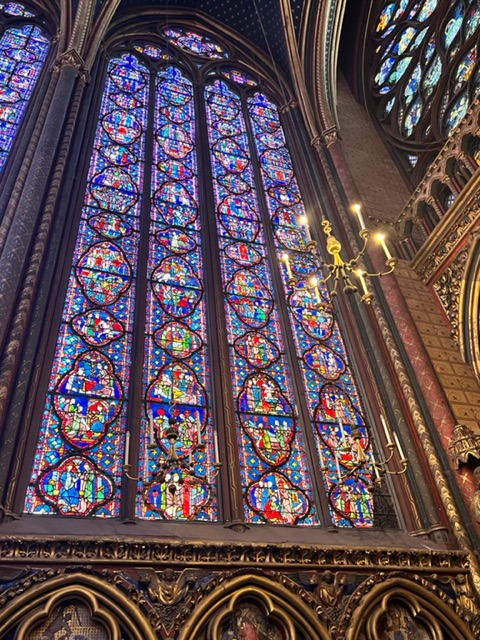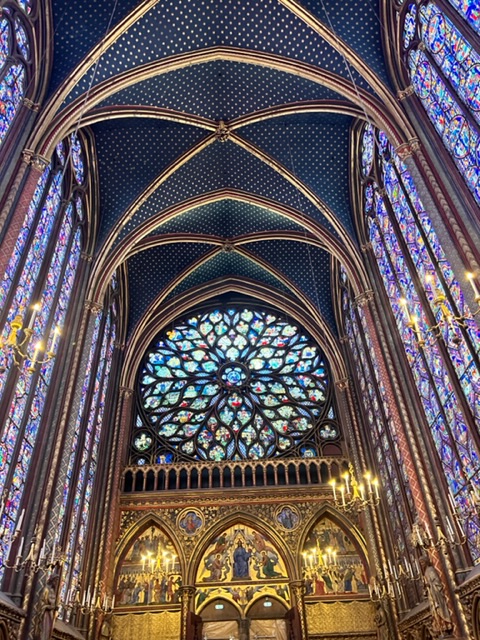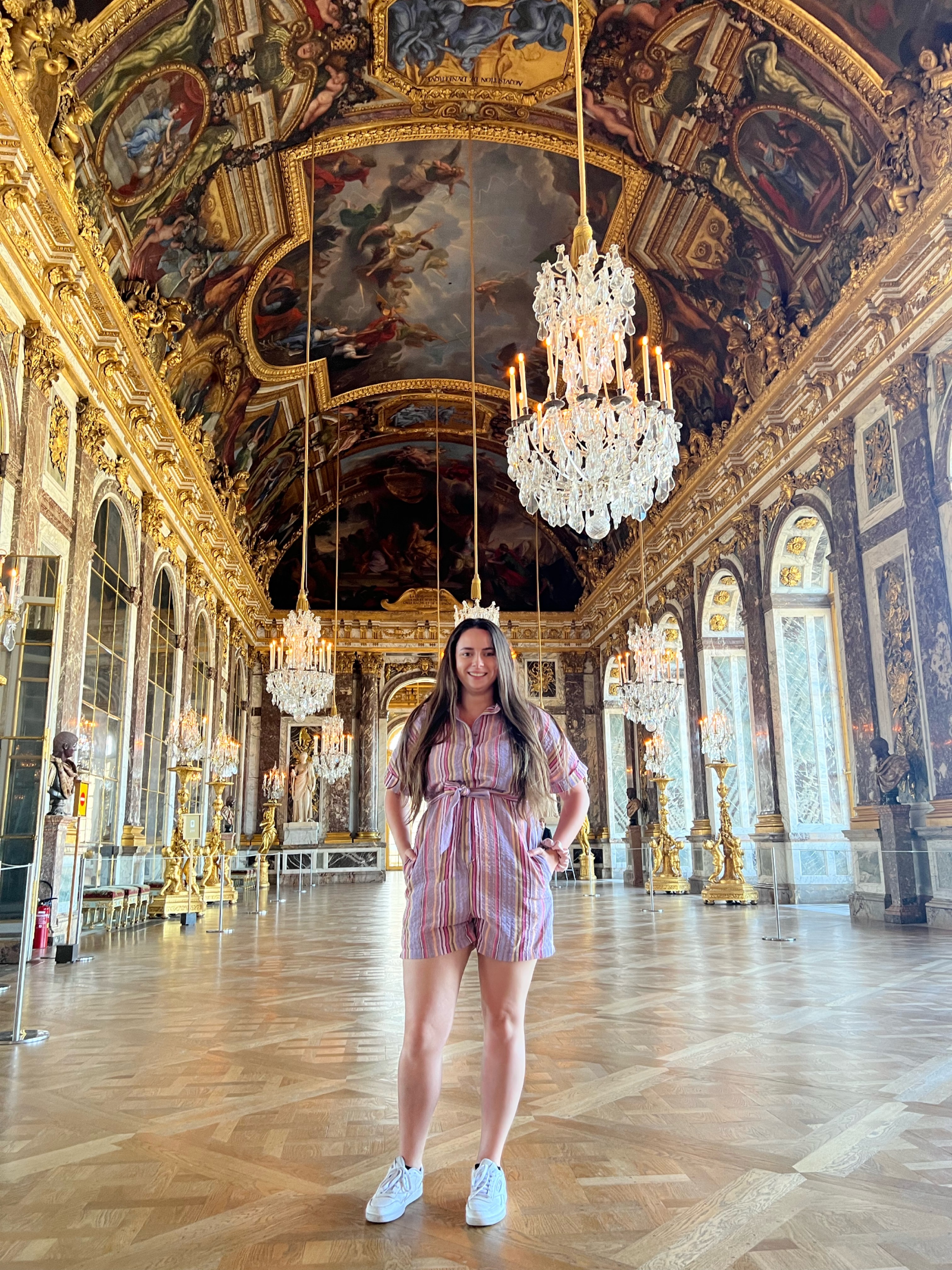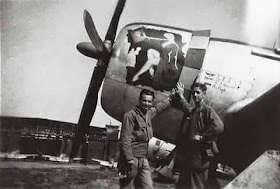
Sophia is a junior at Florida International University majoring in Secondary English education. Some of her hobbies include reading classic novels such as Wuthering Heights and Pride and Prejudice. She lives in Cutler Bay with her husband and two dogs. Her topics of interest include women’s rights, equitable education, and human rights. She enjoys spending time on her boat out in the Florida Bay, exploring new restaurants in Miami, and watching the occasional netflix show.
Paris as text



“A King, A Church, and A Window”
Some of the most beautiful, intricate, and ancient stain glass can be found in Sainte Chapelle in Paris, France. Built between 1241 and 1248 by Louis IX, Sainte Chapelle served a major purpose. Louis IX wanted to be remembered and ordained by his subjects as a ruler chosen by God. He went on two crusades to conquer the holy land and had many successful battles. His most astonishing victory however, is considered to be the purchase of the crown of thorns and a piece of the original cross. “In purchasing them, Louis IX added to the prestige of both France and Paris which, in the eyes of medieval Europe became a “New Jerusalem” hence the second capital of Christianity.” (Centre des monuments nationaux)
His church Sainte Chapelle was entirely built to house these two momentous relics and to add to Louis IX’s grandeur. To accompany these relics stories of the bible are transcribed through art on the stained glass windows. Stories from the Creation Story, to Kane and Abel, to Moses parting the red sea, to finally the story of King Louis IX’s acquisition of the holy relics. To really understand the importance of these stained glass windows you need to know two things. 1. People who practice catholicism do not read the bible, they have the bible read to them during mass. 2. During this time period in medieval France many people did not know how to read so even if they had a bible it would be useless to them. These stained glass windows turned the major stories of the bible into easily accessible images for followers of the faith to come and look at.
I had never been into a Gothic Style church before, I have seen many basilicas and even been to St Peter’s Basilica at the Vatican. Sainte Chapelle is the most unique church I have ever been in. Looking at the stained glass I understood why Monarchs reigned for so long in this part of the world. A king makes his claim and brings back the crown of thorns, the most valuable piece of Christian history and builds the most elaborate church he can, making sure to highlight his own greatness. How could you not in turn follow his every command? Yet part of me was disillusioned by the notion. With grand gestures comes grand mistakes. King Louis IX went on two crusades both times he lost. It cost him copious amounts of money and many troops. For what? He never retook the holy land. He never rectified Jerusalem. So while Sainte Chappelle is a beautiful ode to Louis IX’s relationship with catholicism it is a glorified story of misfortune.
References:
http://www.sainte-chapelle.fr/en/
Versailles as text



Photo of the Hall of Mirrors, Sophia in the Hall, and Sophia outside the palace CC Sophia Monica 4.0
“Do the ends justify the means?” By Sophia Monica
Walking up to the home of the sun king you are met with a long upward sloping hill. Atop the hill is one of the most ornate buildings I have ever seen. Built of stone and clad with gold accents the Palace of Versailles is a one-of-a-kind masterpiece. When Louis the fourteenth came into power, he decided he wanted to move his family and court to his childhood hunting lodge. He employed some of the best architects, artists, skilled and unskilled laborers to build his dream palace. The palace contains 2,300 rooms and can host thousands of people. One of the most famous rooms at Versailles is the Hall of Mirrors. On this day we were granted special access to the Hall of Mirrors and were able to have five minutes alone as a class to explore.
When I told my husband we were going to see the hall of mirrors he thought it would just be a long hallway of reflective mirrors. Instead, the hall of mirrors is so much more. “Political successes are illustrated through the 30 painted compositions on the vaulted ceiling by Le Brun, which depict the glorious history of Louis XIV during the first 18 years of his reign, from 1661 to the peace treaties of Nijmegen.” (Versailles Tourism) Along with the murals on the ceiling the hall of mirrors features gigantic ornate mirrors, classic chandeliers, and windows facing the gardens. Often Louis XIV would move his throne to the end of the hall and meet foreign dignitaries, they would be greeted by members of his court lining both walls creating a hallway of people down to the king.
Along with the palace there is an expansive garden element to the Palace of Versailles. Marie Antoinette wife of Louis XVI wanted her own French farm on the property, so they built a real working farm. When we walked up to her farm, we could not believe it, it looked like a movie set. It was clean and the buildings were almost like cardboard cut outs. It was so far removed from an actual working farm that it was comical. Throughout our time exploring the palace and gardens I was met with an uncomfortable notion. Versailles was built so the King could escape Paris, he wanted to be away from his subjects. It worked for Louis XIV because he was sure of himself and his reign. Being so far removed from his subjects did not work for Louis XVI. Some would argue that the French revolution happened because Louis XVI was so far removed from what was happening in the nation. But do the ends justify the means? Did building Versailles mean anything to the world in the end?
I like to think Versailles is still a cultural icon. People from around the world come to the hall of mirrors. Yet, the disconnect between Louis XVI living there and his subjects’ conditions of life makes Versailles controversial. The people of France were starving while Louis XVI was spending millions of dollars on making Versailles his own. Marie Antoinette would gamble taxpayers’ money away at poker nights in her affair home on the property. People were starving and they were so far removed that they had no idea and did not care. While Versailles still stands it is plagued with disconnection. Being a cultural icon and a place of grandeur at the cost of the monarchy and the pain of the people.
“The Hall of Mirrors.” En.versailles, 2022, https://en.versailles-tourisme.com/the-hall-of-mirrors.html.
Lyon as text

“The Spark” By Sophia Monica
There is a distinct moment in an individual’s life that shapes and changes them as a person, a moment where perspective shifts and realization sets in. My moment happened on July eighth two thousand twenty two.
On September third nineteen thirty-nine France declared war on Germany. Shortly after on June 22, 1940, France divided into two, occupied France and the Vichy government. Vichy France was considered Free France, yet they collaborated with the Nazis and a decision was made. It started with the Jews not being allowed to work government jobs, from there it continued in a downwards spiral. Jews had to register with the government and were forced to carry identification cards. In March of 1941 the Vichy government created an agency called the General commission for Jewish affairs. The agency oversaw collecting all Jewish belongings. Then in 1942 the unthinkable happens. “After securing an agreement of the Vichy government, German officials and French police conducted round-ups of Jews in both occupied and unoccupied zones of France.” (Holocaust encyclopedia, 2) At this time Claude Bloch was fifteen. On June 29th, 1944, Bloch was arrested in his family apartment by French officers. When officials arrived they were told to pack, Bloch’s mother made him put on pants. His mother, grandfather, and he were taken to Montluc prison. At the time since he was 15 Bloch was considered an adult. The cells at Montluc were four meters by four meters in size and at one time would hold up to 10 adults. Because there were only 127 cells at Montluc they were forced to create a shack in the yard, which they labeled the “Jew” shack. The Jew shack was where they would place all adult male Jews. Anywhere from 200-350 people would be incarcerated in this shack at any time.

French officers took Bloch, his mother, and grandfather and questioned them. While questioning him and his grandfather, authorities decided they did not like what the grandfather had to say and executed him. Bloch could not comprehend what had happened. They took him to a cell with his mother and she asked where his grandfather was, he said “he didn’t make it.” After a night at Montluc in a cell with his mother they moved Bloch to the Jew shack, a little while later he was sent to Birkenau. They were placed on an open train and transported like cattle. When they arrived, they were divided into two groups: men and women and children. Bloch wanted to go in line with his mother, being a skinny 15-year-old, he thought he would be able to blend in. He tried to jump lines during a commotion but when he got in line with his mother, she pushed him away. It was the last time he ever saw her. After he was processed he was sent to Auschwitz and there he worked hard labor 12 hours a day. It is at this point that I realized his story was going to change me as a person. Bloch said when he arrived they shaved his head, took his clothes, tattooed a number on his arm, and made him find a uniform that fit. From there he was placed in a building with many others. In the mornings they would take roll and every person was expected to be there. In the night many people would die in their bunks due to dehydration or exhaustion. The Jews were expected to carry out the bodies of their deceased comrades and line the corpses up in formation. The same was expected of them in the afternoon when people would die during the work day. Hearing this I broke. As a person with an immense amount of empathy I pictured this 93 year old man in front of me carrying his dead friend’s body at 15 years old. The pain and suffering he went through made me realize just how valuable a human life is. Bloch says his mother gave life to him three times, when she birthed him, when she told him to put on pants, and when she pushed him away in line. If he had been wearing shorts he would have been considered a child. All of the children he saw at Birkenau did not survive. They were taken into an area that looked like showers and were gassed to death.
Bloch ultimately survived the holocaust. I say he “survived,” in the most primitive form. Yes he lived, his heart still beat and his mind still raced. But the holocaust took something from him, it stripped him of his humanity and tried to turn him into a number. Bloch tells his story now, not to have people pity him. He tells it so that something like this NEVER happens again. It is hard to remain optimistic about the future when there are events similar to the holocaust still happening. Children are being killed in Ukraine for no reason other than a land grab. However, I realized it falls on me and my generation. It is up to us to ensure something like this never happens again, to speak out when we witness injustice. It is up to us to condemn racism. It is up to us to be accepting of other religions. So while his story was tragic it changed me. It sparked a fire for humanity that I did not have before. It made me angry, it made me sad, but most of all it made me want to take a greater stand.
“Claude Bloch.” Déporté·e·s De Lyon Et Sa Région, https://www.deportesdelyon.fr/les-familles-de-lyon/parcours-claude-bloch
United States Holocaust Memorial Museum, United States Holocaust Memorial Museum, https://encyclopedia.ushmm.org/content/en/article/france.
Izieu as text




Photo of Masion Izieu, Lucinne Friedler, art done by the children, and the view from the home CC Sophia Monica 4.0
“They were murdered” By Sophia Monica
In 1939 when France declared war on Germany I am sure nobody thought that children would be murdered in France for simply being Jewish. Yet that’s exactly what happened. In a small countryside town Izieu, a home for Jewish children was raided by a horrific man, Klaus Barbie. He came with 10 soldiers, took the children to the prison Montluc and then sent them to Birkenau. The children ranged in age from 2 years old to 16. When France divided itself into occupied France and “Free France ” many Jewish parents living in Paris decided they needed to get their children to safety. At the time, the lower portion of France near Italy was given to the Italians. Italians were not as harsh in their persecution of Jews. Their primary mission was to eradicate communism. Knowing this, Jews decided to send children to the Italian occupied French countryside. There the children would have a normal childhood filled with games, learning, laughing, and innocence. When American soldiers started retaking Italy which ultimately fell, the Nazis took over Izieu. It was discovered that the children at the home were in fact Jewish and they were taken.
Walking up to the memorial at Izieu you are met with an overwhelming feeling of tranquility. Buried in the mountains there are fields of wild flowers and rolling hills. The fountain in front of the home fills you with peace. It is at this moment you realize what exactly happened here. Children were robbed of their innocence. They were murdered. As we walked inside the home I started to feel a slight tinge of anger. It was not until we walked into what I am calling the memory room that I was filled with the most anger I’ve ever felt in my entire life. Lining long colored tables there are pictures and letters from the children that lived at the home. These dated letters are to their parents, telling them how happy they are at “camp” explaining how they are doing in class, how they play outside, and thanking them for gifts they received. There are hand drawn pictures of war, death, compassion, and imagination that are placed next to the letters. It was hard to read about their joy knowing what comes next. We walked up to the upper level of the home where the children slept and attended class. Seeing the desks they sat at to learn geography and worldly ideas I couldn’t help but feel connected to the space. These children were granted a normal childhood up until they were arrested. Right next to the classroom there is a small room with pictures of all of the children who were sentenced to death. Except for one. Luccine Friedler, 5 years old does not have a single photo of her likeness. Every other child has at least one photo, but Luccine was not granted that gift. Looking at her blank picture frame my heart aches for the parents of these children, many of whom survived the holocaust. Imagine being a parent and making the decision to send your kids to the countryside to have a better life and then get the news that they were sent to a concentration camp and killed. I myself would not be able to live with that decision.
What made me the most angry was when I heard that Klaus Barbie was saved by the Americans and sent to do top secret work in South America. He tortured and murdered hundreds if not thousands of people and was able to survive unscathed. French Nazi hunters Serge Klarsfeld and Beatte Kunzel tracked Barbie in Bolivia. They arrested him and brought him back to France where in May of 1987 he was tried for his crimes against humanity. He was sentenced to life in prison because there is no death penalty in France.
These children were murdered and Klaus Barbie was responsible. After we left the site I wanted to punch a wall, how could this man do this to these children? I wanted him to suffer, at least be sentenced to death. Then I remembered a quote I saw in the museum from my favorite Holocaust survivor and writer Elie Wiesel “ce proces pesera sur l’avenir au nom de la justice, au nom de la momoire. Une justice sans memoire est une justice incomplete, fausse et injuste.” translated in english to “This trial will weigh on the future in the name of justice, in the name of remembrance. A justice without memory is an incomplete, false and unjust justice.” In order to be better we have to do what is right, holding a fair trial for him and allowing the law to dictate his future needed to happen. The holocaust was barbaric, humanity was almost lost, and the actions were unjust. We can never let ourselves repeat that, so we must move forward and be fair.
Sources:
“Butcher of Lyon,” Former Nazi Gestapo Chief, Charged with War Crimes.” Google, Google, https://www.google.com/amp/s/www.history.com/.amp/this-day-in-history/butcher-of-lyon-on-trial.
United States Holocaust Memorial Museum, United States Holocaust Memorial Museum, https://encyclopedia.ushmm.org/content/en/article/france.
Normandy as text

George Rarey
By: Sophia Monica
With war comes the destruction of life, loss of security, and rebirth of humanity. While war and its actions are hard to swallow, sometimes it is a necessary evil. World War two was a necessary war. When human beings are being slaughtered in the millions due to their race, religious beliefs or sexuality they must be protected. I am very fortunate to live in a patriotic country where men and women are willing to lay down their lives everyday to protect our unalienable rights. Below is a story of an American man who did exactly that and it cost him his life. As you read his story please remember he is one of many and they all deserve our remembrance and gratitude.
In Oklahoma on May 17 1917 a woman gave birth to a son, whom she named George Rarey. Rarey spent his childhood attending school in Enid Oklahoma and when he came of age he left the rural state for Greenwich Village New York City. Rarey had a dream of becoming a cartoon illustrator and in 1941 his dream became a reality. He started work as a commercial cartoon artist. That same year he fell in love with Junie, his future bride. His nickname for her, Betty Lou. With the state of the world rapidly deteriorating and his love of country Rarey decides to join the Army Air Corps. After a stint at bootcamp George Rarey is accepted to pilot school, which is quite the feat. It is also ironic because he is allowed to pilot an aircraft but does not have his driver’s license and has never driven a car. After his pilot school graduation he joined the 362nd FG. The main mission of the group was dive bombardment. After this he went to Scotland where he flew P-47’s.His squadron would call him grandpa or pappy because he was the oldest one in the group. In his freetime Rarey would illustrate cartoons of the things happening around him. He was also well known for his dedicated nose art, that he would design and paint on the division planes.



Photo CC USAF Nose art
On March 22nd 1944 he received a yellow envelope. His wife Junie “Betty Lou” had given birth to their son. She decides to name him Damon. He writes a letter in response to hers. In part of his letter he says “This is really living. . . .What a ridiculous and worthless thing a war is in the light of such a wonderful event….” (Rarey, 1944) In his note he includes a cartoon of himself thinking about his wife and new baby. On June 6th of 1944 Rarey and his squadron embarked on their D-day plane mission. It is a successful run dropping paratroopers from the 82nd and 101st airborne divisions. From there they keep doing runs. June 27th 1944 Rarey prepares for his 67th mission a reconnaissance on Granville, at 5;00 pm above the town of Villers-Bocage he is hit and crashes 800m west of the town. He did not have time to eject and died on impact. The Germans in the area see the crash and mistake him for an English pilot. They proceed to wrap him in his parachute and bury him in a ditch, they put up a sign saying “here lies an English airman”
George Rarey never got to meet his son. He died at 27 years old.
Through all the pain and hardship war brought, Rarey was a bright light for the soldiers around him. When he died his unit had so many positive things to say about him. “You never heal from the loss of a guy like this” . S/SGT John W. BENSON “Whatever fun there was in this war, it’s all over now.” Captain William FLAVIN. Rarey focused on his art he produced many cartoons during his time in the Army Air Corps and painted over 50 nose pieces on planes. He made art in a time of pain. I can not imagine going to war and never getting to meet my child. That is a parental pain I do not think I could endure. My husband is active duty in the military and the thought of him never meeting our child absolutely crushes me. Yet somehow George kept his morale up even though he did not like the war and missed his son’s birth. One of the most interesting parts about George Rarey’s life to me is his career before joining the military, his time as a cartoonist. I am inspired by his continuation of his art through the war and channeling his talent into plane nose art. His cartoons and art will always hold a place in my heart. George Rarey’s son Damon Rarey with the help of his mother collected all of his father’s letters and illustrations and comprised a book he titled “Laughter and Tears: A Combat Pilot’s Sketchbooks of World War II Squadron Life.” It is a beautiful legacy left behind about a man who gave his life for his son and country.

“Rarey George W – 379 FS 362 FG.” RAREY George W – 379 FS 362 FG, https://www.database-memoire.eu/prive/fr/normandy-tous-soldats/53-colleville-r-fr/1325-rarey-george-w-379-fs-362-fg.
“‘You Mustn’t Let It Bother You Too Much.’” AMERICAN HERITAGE, 1 July 2022, https://www.americanheritage.com/you-mustnt-let-it-bother-you-too-much#9.
Pere Lachaise As text
Gertrude Stein
“A Legendary Icon” By Sophia Monica
A legendary icon you are,
Bold in your acceptance of yourself
You go with your gut
Your desire for others to succeed
Before yourself
Scared of no man
Loved by one woman
Never really breaking through
Until you met your crowd
Cubism and it’s creators
You changed the world forever
Without you there would be no cubism
Without you there would be no avantguard
Without you there would be no safe space
To create works unaccepted by the world
A legendary icon you are,
I thank you for being strong
For changing the world in the form of art
For allowing yourself to love
When the world was against you and your woman
For stepping up when millions of your kind were being killed
For being unapologetically yourself
I strive for a life like yours
To be as accepting as you
To be as bold as you
And to love as deep as you
To be a legendary icon
Gertrude Stein was a legendary icon to say the least. She was born in Allegany county Pennsylvania and was raised Jewish. She studied at the Harvard annex then she and her brother Leo moved overseas to England then Paris. She and her brother were very close until Stein met the love of her life Alice Toklas. The pair met in 1907. She quickly moved into Leo and Gertrudes apartment at 27 rue de Fleurus. When Alice moved in Leo moved out, which led to Gertrude becoming manager to some of the most well known cubist artists. She is recognised for launching the careers of Pablo Picasso, Henri Matisse, and Juan Gris. She opened up her apartment and it became a sort of gathering place for talented young artists. Gertrude was also a striving writer and has written many works such as “Three Lives” which is said to be her best book. Many young writers crossed paths with Stein. Ernest Hemingway, F. Scott Fitzgerald, and Sherwood Anderson, and Jaymes Joyce. It is not known whether or not Stein directly influenced these writers and their works. One thing is for certain though, Gertrude Stein had an impact on every person she came into contact with.
At a time when the world was unaccepting of her, she decided to be accepting of others. She turned Paris into a refuge for starving young artists and helped them succeed. Her impact still lives on today. Without her Pablo Picasso might never have broken through, we might never have been graced with cubism. F Scott Fitzgerald might never have written The Great Gatsby. It just goes to show, you never know how far your impact can reach.
References
https://jwa.org/encyclopedia/article/stein-gertrude
https://www.radiofrance.fr/franceculture/gertrude-stein-l-audacieuse-4798935
Sophie:
I read your several pieces on your visit to France and the deep emotion you experienced learning about how Hitler and his henchmen, including some Frenchmen, tortured and killed Jewish men, women and children.
Although this is repulsive, it does make you realize how barbaric and Godless men can become if lead by a fanatic.
However, it should also make you appreciate our country and government of the People, by the People, and for the People and remain vigilant that it does not perish from this Earth. As we all enjoy our unalienable rights of Life, Liberty and the pursuit of happiness, we should also remember that we are one of the privileged People on this Earth who enjoy these individual rights. Never take them for granted!!
Take care,
Grandpa
LikeLike